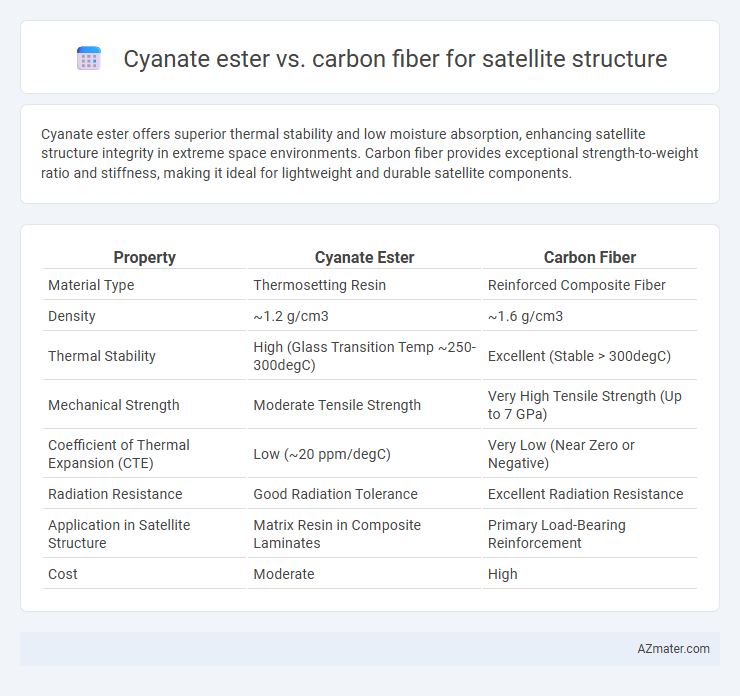Cyanate ester offers superior thermal stability and low moisture absorption, enhancing satellite structure integrity in extreme space environments. Carbon fiber provides exceptional strength-to-weight ratio and stiffness, making it ideal for lightweight and durable satellite components.
Table of Comparison
| Property | Cyanate Ester | Carbon Fiber |
|---|---|---|
| Material Type | Thermosetting Resin | Reinforced Composite Fiber |
| Density | ~1.2 g/cm3 | ~1.6 g/cm3 |
| Thermal Stability | High (Glass Transition Temp ~250-300degC) | Excellent (Stable > 300degC) |
| Mechanical Strength | Moderate Tensile Strength | Very High Tensile Strength (Up to 7 GPa) |
| Coefficient of Thermal Expansion (CTE) | Low (~20 ppm/degC) | Very Low (Near Zero or Negative) |
| Radiation Resistance | Good Radiation Tolerance | Excellent Radiation Resistance |
| Application in Satellite Structure | Matrix Resin in Composite Laminates | Primary Load-Bearing Reinforcement |
| Cost | Moderate | High |
Introduction to Satellite Structure Materials
Cyanate ester resins provide exceptional thermal stability and low moisture absorption, making them ideal for satellite structures exposed to harsh space environments. Carbon fiber composites offer high strength-to-weight ratios and excellent stiffness, essential for maintaining structural integrity during launch and orbit. Combining cyanate ester matrices with carbon fiber reinforcement results in lightweight, durable satellite components with enhanced resistance to radiation and thermal cycling.
Overview of Cyanate Ester Composites
Cyanate ester composites exhibit exceptional thermal stability, low moisture absorption, and high mechanical strength, making them ideal for satellite structures exposed to extreme space environments. Their inherent resistance to radiation and minimal outgassing properties reduce contamination risks and enhance satellite longevity. These composites offer superior dimensional stability compared to traditional epoxy-based carbon fiber materials, ensuring reliable performance during thermal cycling in orbit.
Key Properties of Carbon Fiber
Carbon fiber exhibits exceptional tensile strength, low density, and excellent stiffness, making it ideal for satellite structures requiring high strength-to-weight ratios. Its thermal stability and resistance to fatigue enhance the durability and longevity of space components under harsh environmental conditions. Compared to cyanate ester composites, carbon fiber offers superior structural integrity and reduced weight, optimizing satellite performance and fuel efficiency.
Mechanical Strength Comparison
Cyanate ester composites exhibit superior thermal stability and moisture resistance, making them ideal for satellite structures requiring dimensional stability under extreme conditions, while carbon fiber composites offer higher tensile strength and stiffness essential for load-bearing components. Mechanical strength of carbon fiber typically ranges from 3.5 to 7 GPa in tensile strength with a modulus of 230-600 GPa, whereas cyanate ester resins provide excellent matrix durability but rely on reinforcement fibers for mechanical load capacity. The combination of carbon fiber reinforcement in cyanate ester matrices often results in a composite with optimized mechanical strength, balancing rigidity and environmental resilience critical for aerospace applications.
Thermal Stability and Resistance
Cyanate ester resins exhibit superior thermal stability with glass transition temperatures often exceeding 250degC, making them highly resistant to thermal degradation in satellite structures. Carbon fiber composites reinforced with cyanate ester matrices provide enhanced dimensional stability and maintain mechanical integrity under extreme thermal cycling encountered in space environments. The combination of cyanate ester resin systems and carbon fiber reinforcement results in satellite components that effectively resist thermal expansion, outgassing, and microcracking, ensuring long-term performance and reliability in orbit.
Moisture Absorption and Environmental Durability
Cyanate ester resins exhibit significantly lower moisture absorption compared to traditional carbon fiber composites, enhancing dimensional stability in satellite structures exposed to humid or space environments. The superior environmental durability of cyanate ester systems, including resistance to thermal cycling and radiation, ensures prolonged structural integrity and performance in orbit. Carbon fiber composites, while offering high strength-to-weight ratios, often require protective coatings to mitigate moisture-induced degradation and environmental stress in aerospace applications.
Outgassing Characteristics in Space
Cyanate ester composites exhibit lower outgassing rates compared to standard carbon fiber materials, making them superior for satellite structures where contamination control is critical. Their inherently low total mass loss (TML) and collected volatile condensable materials (CVCM) values minimize the risk of contaminant deposition on sensitive optical and electronic components in space. This characteristic enhances the reliability and longevity of satellite systems operating in the vacuum environment.
Weight and Structural Efficiency
Cyanate ester composites offer superior thermal stability and moisture resistance compared to standard epoxies, making them ideal for satellite structures exposed to harsh space environments. Carbon fiber reinforcement significantly enhances the strength-to-weight ratio, resulting in lightweight components with high structural efficiency essential for launch cost savings. Combining cyanate ester resins with carbon fiber reinforcement yields structures that maintain rigidity and dimensional stability while minimizing mass, critical for optimizing satellite performance and payload capacity.
Cost and Manufacturing Considerations
Cyanate ester composites offer superior thermal stability and low moisture absorption, making them ideal for high-performance satellite structures, but they typically come at a higher material cost compared to traditional carbon fiber composites. Manufacturing cyanate ester materials requires precise temperature control and longer curing cycles, increasing production complexity and expenses relative to the more established carbon fiber fabrication processes. Cost-effectiveness in satellite structure fabrication often depends on balancing the enhanced durability and thermal properties of cyanate esters against the faster, more cost-efficient manufacturing and widespread availability of carbon fiber composites.
Application Suitability for Satellite Structures
Cyanate ester resins provide superior thermal stability, low moisture absorption, and excellent dimensional stability, making them ideal for satellite structures exposed to extreme space environments. Carbon fiber composites combined with cyanate ester matrices offer high strength-to-weight ratios and enhanced resistance to radiation and thermal cycling, crucial for maintaining structural integrity in orbit. Their synergy results in lightweight satellite components with improved reliability and long-term performance in aerospace applications.

Infographic: Cyanate ester vs Carbon fiber for Satellite structure
 azmater.com
azmater.com